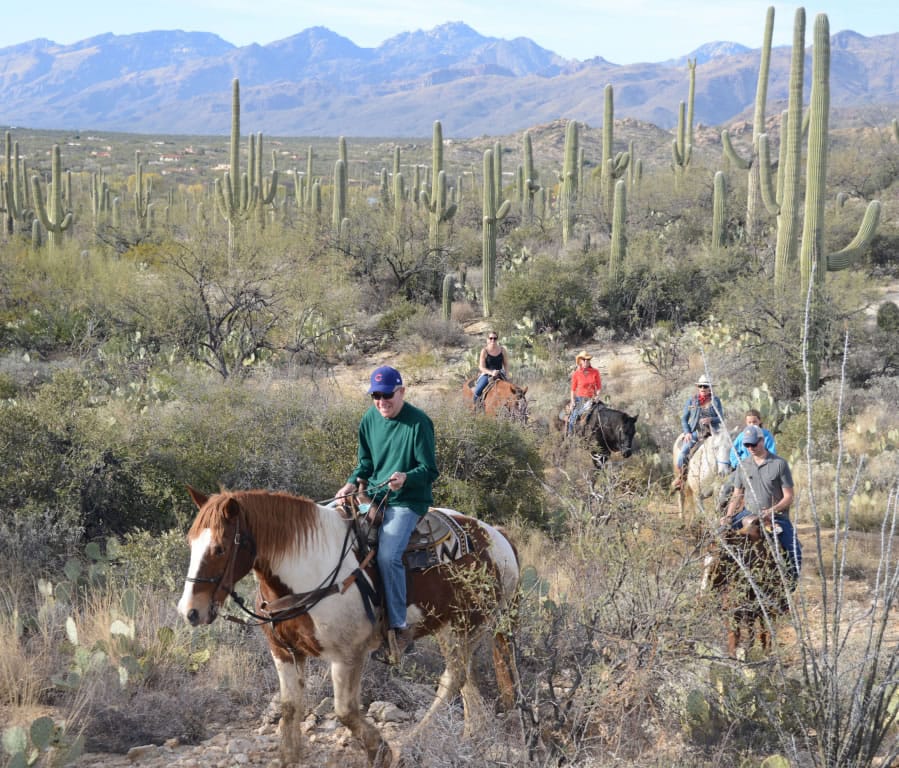We rode our line of horses along a trail winding between giant saguaro cactuses towering nearly 30 feet in the air like spiky desert signposts.
Despite being in southern Arizona, we shivered in the December winds, the desert hills above us painted an incongruous white with frost. Our motley crew of the old, young and unsteady plodded along on horseback like a lost pioneer troupe. Fortunately, the grizzled veteran wrangler leading our trail ride signaled that the chuck wagon was in sight.
We were on a breakfast ride at Tanque Verde Ranch, a Western resort that’s been in business since the 1920s. This ride was a homecoming of sorts; I’d done the same trip as a kid when my family of five traveled from the Chicago suburbs to this venerable dude ranch over 30 years ago. Now I was back with 10 of us, three generations of family members from across the country to see how the ranch — and our idea of a family vacation — has changed.
The concept of a dude ranch vacation began in the 1880s, as Teddy Roosevelt and other East Coast “dudes” (an insulting term back then for clueless city posers) went out West to play at being cowboys. Since then, dude ranches have evolved to include high-end resorts with a few horses, working cattle ranches, rugged horseback wilderness adventures and everything in between. The increasing popularity of experiential travel has been a boon for dude ranches.
At Tanque Verde, cattle still graze across 60,000 acres of leased U.S. Forest Service terrain, but the main business is hosting guests on its 640-acre property. A large corral complex with 150-plus horses and a big team of wranglers gives Tanque Verde the feel of a cavalry training operation. Classes are offered for beginning and advanced riders, with learning applied on a series of walking, loping and adventure rides into the nearby mountains.
These horse-focused activities filled my experience visiting the ranch as a kid in the 1980s. While the corrals remain the same, including wrangler Joe Valdez who’s been taking city slickers out on the trails for 45 years, my childhood memories definitely don’t include the newer ranch activities of mountain biking, tennis, yoga, spa treatments and water aerobics.
Tanque Verde’s guest lodging began as a few rooms attached to the main building and has since expanded to more than 65 rooms ranging from basic “salas” to expansive three- and four-bedroom Santa Fe-style haciendas whose pink and orange hues blend into the desert sunsets. The rooms can be rustic to a fault — some apparently not updated since my first visit — but renovations are planned.
The dining experience remains a communal affair in the main lodge, with hearty Southwestern buffets mixing frontier meat-and-potatoes with healthy greens and Mexican-themed food nights. The Doghouse Saloon provides pre- and post-dinner libations, like the popular prickly pear margarita, along with card and pool tables. A clunky TV that used to be propped on a table has given way to multiple flat screens.
The family experience is part of dude ranch DNA. One family spanning four generations has been coming to Tanque Verde annually for the past 55 years.
“It’s about the traditions, the memories, the shared experiences that keep our guests coming back,” general manager Rita Cote said.
When I visited back in the day, I remember my little sister Amy, maybe 5 years old, almost doing the splits as she straddled the saddle of fat, docile Oats, the mellow horse favorite for kids. This time, I watched Amy help her daughter Esme, outfitted in pink cowgirl gear, get ready for her ride atop another comically large horse.
Returning to the ranch as an adult, it was comforting to see that some things were still the same. The saguaro-dominated desert landscape remained unchanged. The horses still wanted to stop to eat shrubs on the trail. Kids still found equine flatulence hysterical. And the old wranglers were as cranky as ever. “But after two decades here, Joe actually started speaking in complete sentences,” Cote boasted.



